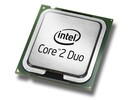Intel Core 2 Duo T6600 vs Intel Core 2 Duo T9900 vs Intel Core 2 Duo SP9300
Intel Core 2 Duo T6600
► remove from comparisonDie Intel Core 2 Duo T6600 Dual-Core CPU ist ein Mittelklasse Dual-Core Prozessor für Notebooks. Die Architektur des Prozessors basiert auf den Penryn Kern und wird in 45nm gefertigt. Im Vergleich zu stärkeren T-Prozessoren bietet der T6600 keine Virtualisierungsfunktionen (Virtualization Technology VT-x) und nur 2 MB Level 2 Cache (Topmodelle bis zu 6 MB). Der Stromverbrauch ist jedoch auch mit max. 35 Watt spezifiziert (TDP).
Durch die mittelmäßige Taktfrequenz und den kleinen Level 2 Cache, kann die CPU bei modernen und anspruchsvollen Spielen durchaus limitieren (z.B. große Multiplayerschlachten bei Supreme Commander). Für die mittelmäßig anspruchsvolle (nicht professionelle) Anwendungen wie Office, Entry-Level Videoschnitt, Bildbearbeitung, Internet und casual Gaming sollte die Leistung jedoch ausreichen.
Der Penryn (Montevina Update) Kern bietet 2 Integer Units, 1 Floating Point Unit, 1 Load Unit und 1 Store Unit in einer 14-stufigen Pipeline. Mit der Wide Dynamic Execution Technologie kann der Kern bis zu vier volle Instruktionen gleichzeitig ausführen.
Dank Dynamic Acceleration (später Turbo Modus genannt), kann sich ein Kern um eine Stufe übertakten, wenn der zweite im Idle Modus (Leerlauf) ist.
Das integrierte Enhanced Speedstep kann die Taktfrequenz des Prozessors dynamisch an die Leistungsanforderungen anpassen. Dadurch läuft die CPU ohne Last nur mit 800 MHz.
Der Core 2 Duo T6600 passt in den Socket P (PGA478)
Intel Core 2 Duo T9900
► remove from comparison
Die Intel Core 2 Duo T9900 Dual-Core CPU löst praktisch den Core 2 Extreme X9100 (ebenfalls 3.06 GHz und 6MB L2 Cache) ab und hat zusätzlich noch einen deutlich geringeren Stromverbrauch (35 versus 44 Watt TDP dank verbessertem Stepping und Enhanced Halt State (C1E)). Einzig der freie Multiplikator unterscheidet den X9100 noch vom T9900 und bietet einen Vorteil (die einfache Übertaktbarkeit per Erhöhung des Multiplikators). Die Architektur des Prozessors basiert auf den Penryn Kern und wird in 45nm gefertigt.
Dank der hohen Taktung von 3 GHz, ist die Performance für die alle Spiele in 2009 ausreichend (nur GTA 4 profitiert deutlich von mehr Prozessorkernen). Die alten Core 2 Quad Mobilprozessoren (Q9000, QX9300) werden dank der hohen Taktung bei den meisten Spielen deutlich geschlagen. Nur Anwendungen welche mehr als 2 parallele Threads effizient nutzen können (z.B. 3D Rendering) sind auf Quad-Core Prozessoren schneller. In der Einzelthreadperformance können erst die aktuellen Core i7 Modelle den T9900 deutlich abhängen.
Der Penryn (Montevina Update) Kern bietet 2 Integer Units, 1 Floating Point Unit, 1 Load Unit und 1 Store Unit in einer 14-stufigen Pipeline. Mit der Wide Dynamic Execution Technologie kann der Kern bis zu vier volle Instruktionen gleichzeitig ausführen.
Dank Dynamic Acceleration (später Turbo Modus genannt), kann sich ein Kern um eine Stufe übertakten, wenn der zweite im Idle Modus (Leerlauf) ist.
Das integrierte Enhanced Speedstep kann die Taktfrequenz des Prozessors dynamisch an die Leistungsanforderungen anpassen. Dadurch läuft die CPU ohne Last nur mit 800 MHz.
Der Core 2 Duo T9900 passt in den Socket P (mit 479 Pins):
Socket P / Micro Flip-Chip Pin Grid Array (Micro-FCPGA) requires 479-pin surface mount Zero Insertion Force (ZIF) socket (mPGA479M socket) or Micro Flip-Chip Ball Grid Array (Micro-FCBGA) for surface mount (479-ball)
Intel Core 2 Duo SP9300
► remove from comparisonDer Core 2 Duo SP9300 ist ein sparsamer Mittelklasse Doppelkernprozessor. Im Vergleich zu anderen Core 2 Duo Prozessoren mit 2.26 GHz, bietet der SP9300 den vollen 6MB Level 2 Cache des Penryn Kerns. Weiters sind alle Features des Kerns aktiviert (VT-x, Trusted Execution).
Dank der 6 MB Level 2 Cache, ist die Performance besser als bei gleichgetakteten Core 2 Duo Modellen (z.B. P8400).
Benchmarks
Average Benchmarks Intel Core 2 Duo T6600 → 100% n=11
Average Benchmarks Intel Core 2 Duo T9900 → 174% n=11
Average Benchmarks Intel Core 2 Duo SP9300 → 112% n=11
* Smaller numbers mean a higher performance
1 This benchmark is not used for the average calculation












